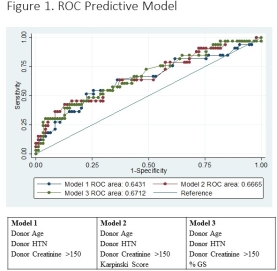Preimplant Donor Histology Does Not Improve Discrimination of 5 Year Kidney Allograft Outcomes.
1Nephrology, Duke University Hospital, Durham, NC
2Nephrology, Beaumont Hospital, Dublin, Ireland.
Meeting: 2016 American Transplant Congress
Abstract number: C201
Keywords: Donation, Graft survival, Kidney transplantation
Session Information
Session Name: Poster Session C: Kidney Transplantation: AKI/Preservation/DCD
Session Type: Poster Session
Date: Monday, June 13, 2016
Session Time: 6:00pm-7:00pm
 Presentation Time: 6:00pm-7:00pm
Presentation Time: 6:00pm-7:00pm
Location: Halls C&D
Kidney transplantation remains the best treatment option for End-Stage Kidney Disease (ESKD) and the most cost efficient method of renal replacement therapy. However, there is a shortage of donor organs, driving an increase in the use of extended criteria donors (ECD). Pre-implant kidney biopsy is used to determine suitability of marginal donor kidneys for transplantation. However, data on the ability of baseline histology to predict medium-term graft outcome is limited. This retrospective study aimed to determine if pre-implant histology can identify cases of eGFR ≤35 ml/min/1.73m[sup2] at five year follow up beyond a clinical predictive logistic regression model. We also compared outcomes of dual kidney transplants with standard single kidney transplants. Of 1195 transplants, 171 received a pre-implant kidney biopsy and 15 were dual transplants. Patient survival rates for standard, biopsied and dual kidney transplants were 90.0%, 85.6% and 78.9% respectively (p=n.s.). Graft survival rates for standard, biopsied and dual kidney transplants were 80.0%, 76.6% and 79.0% respectively (p=n.s.). Median eGFR was lower in recipients of biopsied kidneys compared with standard kidney transplants (44 vs. 54ml/min/1.73m2, p<0.001). Median eGFR of dual transplant and standard kidney transplants were similar (58 vs. 54ml/min/1.73m2, p=0.64). Glomerular sclerosis (P=0.05) and Karpinski Score (p=0.03) were significant predictors of eGFR at 5-years in multivariate analysis but did not improve discrimination of eGFR ≤ 35ml/min/1.73m[sup2] at 5-years beyond a clinical prediction model comprising donor age, donor hypertension and terminal donor creatinine (C-statistic 0.67 vs. 0.66; P=0.647)  . Pre-implant histology did not improve prediction of medium-term graft outcomes beyond clinical predictors alone. Whilst numbers were small, allograft function of dual transplant kidneys was similar to standard transplants in our study population, suggesting that there is scope to increase utilisation of kidneys considered marginal based on histology.
. Pre-implant histology did not improve prediction of medium-term graft outcomes beyond clinical predictors alone. Whilst numbers were small, allograft function of dual transplant kidneys was similar to standard transplants in our study population, suggesting that there is scope to increase utilisation of kidneys considered marginal based on histology.
CITATION INFORMATION: Traynor C, Dorman T, de Freitus D, Conlon P, O'Seaghdha C. Preimplant Donor Histology Does Not Improve Discrimination of 5 Year Kidney Allograft Outcomes. Am J Transplant. 2016;16 (suppl 3).
To cite this abstract in AMA style:
Traynor C, Dorman T, Freitus Dde, Conlon P, O'Seaghdha C. Preimplant Donor Histology Does Not Improve Discrimination of 5 Year Kidney Allograft Outcomes. [abstract]. Am J Transplant. 2016; 16 (suppl 3). https://atcmeetingabstracts.com/abstract/preimplant-donor-histology-does-not-improve-discrimination-of-5-year-kidney-allograft-outcomes/. Accessed December 29, 2025.« Back to 2016 American Transplant Congress
